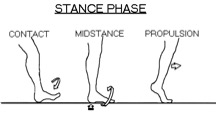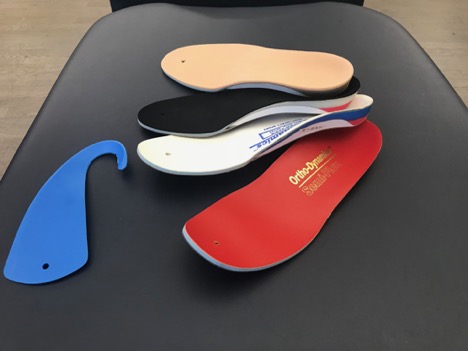I. KINETIC CHAIN AND THE ROLE OF PRONATION
 The foot, ankle, knee, hip, and pelvis are links in a chain from the ground up called the kinetic chain.
The foot, ankle, knee, hip, and pelvis are links in a chain from the ground up called the kinetic chain.
The kinetic chain consists of the:
- Foot
- Ankle
- Knee
- Hip
- Pelvis
Think how effective the body is to be able to walk down the block or go the distance in a marathon. During normal motion the primary shock absorber is foot pronation. That’s right, pronation is “normal.” Pronation is only a problem if it happens to fast, too much, or not at the right time. The muscle that controls pronation is the posterior tibialis muscle. This muscle does not function by shortening(concentric contraction), but by slowing down elongation(eccentric contraction). The end result is the arch of the foot lowering gently to the ground instead of slapping the ground. The secondary shock absorbers are knee flexion and internal rotation of the lower extremity.
II. DYNAMIC MOTION AND THE ROLE SUPINATION
Gait or walking is truly a dynamic motion meaning movement in the sagital, frontal, and transverse plane. Our bone and joint structure facilitates this process. A great example of generating force in all three planes of motion is when you have someone lift your great toe while standing. That toe transmits force to the plantar fascia; note what happens to the foot, knee, and leg. Upon loading that big toe into extension the whole lower limb externally rotates and the arch of the foot raises into supination turning on the powerful muscles of the hip to propel the body forward. The gait cycle is a thing of beauty because as the one side of the body supinates and externally rotates the other pronates and internally rotates storing elastic energy to make the process more efficient and effective. With each step pronation allows shock absorption and the center of gravity to move over the ankle so the hip muscles can spring into extension.
 III. ABNORMAL FOOT MECHANICS AND THE ROLE OF ORTHOTICS
III. ABNORMAL FOOT MECHANICS AND THE ROLE OF ORTHOTICS
Abnormal foot mechanics are manifested by an altered amount, speed, or timing of dynamic joint motion. Pain, bunions, or calluses can be a sign that you are not walking efficiently or effectively. We start with identifying the areas that aren’t moving well and introduce motion through stretching, ART, Graston, and mobilizations. Concurrently we identify areas of weakness to introduce strengthening exercises. The next phase is to address how you move through changing your movement patterns by addressing running technique. Too much motion allows the musculotendinous control to be over stressed; too little motion transmits shock up the kinetic chain. Increases in speed of motion stresses the eccentric muscle control(the brakes). If pronation or supination is at the wrong time there is a disruption of the synchronous action of the kinetic chain. Pain, bunions, or calluses can be a sign that you are not walking efficiently or effectively. Do you need shoes that offer stability, motion control, or minimalist corrections? There are shoes that offer cushion, stability, and even motion control(check out shoe dog). There are pre-fabricated orthotics that offer correction(check out the power step) and custom orthotics(we use orthodynamics as our laboratory). Orthotics could be a correction in your future.

